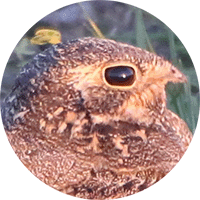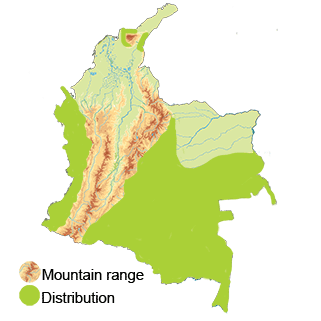Short-tailed Nighthawk
The Short-tailed Nighthawk (Lurocalis semitorquatus) Read in Spanish
Appearance: The Short-tailed Nighthawk is a medium-sized nighthawk species with a distinctive appearance. It has a cryptic plumage that provides camouflage, mainly grayish-brown with intricate mottling and barring patterns. The bird has a relatively short tail, as indicated by its common name, and a broad, slightly rounded wing shape. Its underparts are typically paler than the rest of its body, and it has a white throat patch that contrasts with the surrounding plumage.
Habitat: Short-tailed Nighthawks can be found in a variety of habitats, including tropical lowland forests, forest edges, savannas, and shrublands. In Colombia, they may occur in similar habitats where there is a mix of open spaces for hunting insects and nearby roosting sites in trees or on the ground.
Behavior: These nighthawks are primarily crepuscular and nocturnal, being most active at dusk and dawn. They are skilled aerial hunters, preying on insects such as moths, beetles, and flying ants. Short-tailed Nighthawks are known for their silent flight as they maneuver through the air in search of prey. During the daytime, they typically rest or roost in well-camouflaged locations.
Breeding: Breeding behavior in Short-tailed Nighthawks may include courtship displays such as aerial acrobatics and vocalizations to attract mates and establish territories. Females usually lay one or two eggs on the ground, often on leaf litter or rocky outcrops. Both parents take turns incubating the eggs and caring for the young.
Conservation Status: The conservation status of the Short-tailed Nighthawk in Colombia is not of immediate concern.
Distribution
The Short-tailed Nighthawk (Lurocalis semitorquatus)
Amazon Region: Short-tailed Nighthawks are known to inhabit parts of the Amazon region in Colombia. This area includes the Amazon rainforest and its surrounding habitats, where the nighthawks can be found in forest edges and open areas suitable for hunting insects.
Orinoco Region: The Orinoco region in eastern Colombia is another area where the Short-tailed Nighthawk may be present. This region encompasses a mix of savannas, wetlands, and forests, providing diverse habitats for the nighthawks to forage and roost.
Pacific Region: Short-tailed Nighthawks are also reported in the Pacific region of Colombia, which includes coastal areas and adjacent forests. The nighthawks may utilize this region's forest edges and open spaces for hunting and nesting.
Eastern Andes: Parts of the Eastern Andes mountain range in Colombia provide suitable habitat for the Short-tailed Nighthawk. These birds may occur in the forested slopes and valleys of the Eastern Andes, where they can find ample prey and suitable roosting sites.
Northern Andes: The Short-tailed Nighthawk is also known to be present in the northern Andes of Colombia. This region offers a mix of montane forests, cloud forests, and open areas where the nighthawks can thrive.
Taxonomy
The Short-tailed Nighthawk (Lurocalis semitorquatus)
- Kingdom: Animalia
- Phylum: Chordata
- Class: Aves (Birds)
- Order: Caprimulgiformes
- Family: Caprimulgidae
- Genus: Lurocalis
- Species: Lurocalis semitorquatus
Vocalization
The Short-tailed Nighthawk (Lurocalis semitorquatus)
- Song: Short-tailed Nighthawks are known for their melodious and haunting song, consisting of a series of rhythmic, whistling notes. The song is often heard during the breeding season and is used by both males and females to establish territories and attract mates.
- Calls: Short-tailed Nighthawks produce a variety of calls, including short, sharp "chit" or "chuck" calls that they use for communication within their social groups. These calls can vary in intensity and pitch depending on the context, such as during interactions with other individuals or when alerting to potential threats.
- Churring Sounds: During courtship displays or interactions, Short-tailed Nighthawks may also emit churring sounds characterized by soft, rolling notes. These churring sounds are typically part of the species' behavioral repertoire for mating rituals and pair bonding.
- Flight Calls: While in flight, Short-tailed Nighthawks may produce distinctive flight calls, which can consist of high-pitched or nasal sounds that are repeated as they move through the air. These calls may serve as a means of communication while hunting or navigating their nocturnal habitat.




